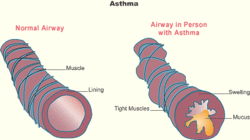What is asthma?
What is Asthma?
En Español[1]

Asthma is a serious, sometimes life-threatening respiratory disease that affects the quality of life for millions of Americans. Although there is no cure for asthma yet, asthma can be controlled through medical treatment and management of environmental triggers. EPA is committed to educating all Americans about asthma so that everyone knows what asthma is, how the environment can affect asthma patients and how to manage environmental asthma triggers.
Asthma Triggers
Learn more about factors found in the indoor and outdoor environment that can cause, trigger, or exacerbate asthma symptoms and what you can do to reduce their impact. You might be surprised by the list of common environmental asthma triggers and how simple it can be to eliminate them from your environment.
Asthma Facts
- Asthma leads to 2 million emergency room visits and 5,000 deaths per year in the U.S.
- Asthma accounted for more than 14 million missed school days in 2000.
- Asthma costs (health care costs and lost productivity) totaled $14 billion in 2002.
Click here to view a list of Frequently Asked Questions
Preventing Asthma Attacks
Step 1 - Talk to a doctor
Talk to a doctor about your child’s asthma. If your child has asthma or if you think your child may have asthma, take your child to a doctor. Your doctor will work with you to keep your child from having asthma attacks.
- Learn what triggers your child’s asthma attacks.
- Identify asthma triggers in your home.
- Talk about ways to get rid of triggers in your home.
- Find out what medicine your child should take.
Step 2 - Make a Plan
Ask your doctor to help you create your child’s Asthma Action Plan. Work with your doctor to create an Asthma Action Plan that will help you learn to prevent your child’s asthma attacks. An Asthma Action Plan will help you control your child's asthma on a regular basis.
Step 3 - Asthma-Proof Your Home
Triggers are a part of everyday life. Asthma attacks can be triggered by things like mold growing on your shower curtain or tiny dust mites that live in blankets, pillow, or your child's stuffed animals.
Learn more about things that might trigger an asthma attack and what you can do to get rid of them and help your child stay healthy. NoAttacks.org
^English
¿Qué es el asma?

El asma es una enfermedad respiratoria crónica que a veces pone en riesgo su vida y que afecta la calidad de vida de millones de personas en los Estados Unidos. Aunque todavía no hay cura para esta enfermedad, la misma puede controlarse por medio de tratamientos médicos y manejando los factores ambientales que la provocan. La EPA se ha comprometido a educar a todas las personas sobre el asma para que así todos conozcan sobre esta enfermedad; como el medio ambiente puede afectar a las personas con la misma, y como manejar los factores ambientales que la provocan.
Factores ambientales que provocan el asma
Conozca más sobre los factores ambientales que se encuentran en el medio ambiente interior y exterior que pueden provocar los síntomas de asma y reducir el impacto de dichos factores. Usted se sorprenderá al ver que tan comunes son estos factores y lo fácil que es eliminarlos de su medio ambiente.
Datos sobre el asma
- En los Estados Unidos el asma conduce a 2 millones de visitas a la sala de emergencias y a 5,000 muertes al año.
- En el año 2000 hubo más de 14 millones de días de ausencias escolares debido al asma.
- En el año 2002 el costo de cuidados médicos y la pérdida de productividad debido al asma fue de $14 billones.
La prevención de ataques de asma
Paso 1 – Hable con un médico
Háblele a su médico sobre el asma de su niño. Si su niño tiene asma o usted piensa que su niño padece de esta enfermedad, lleve su niño a un médico. El médico trabajará con usted para evitar que su niño tenga ataques de asma.
- Aprenda cuáles son las causas del asma en su niño.
- Identifique cuáles son los provocadores de asma en su hogar.
- Aprenda cómo eliminar de su hogar los factores que causan el asma.
- Conozca cuál medicina su niño debe tomar.
Paso 2 – Haga un plan
Pídale a su médico que le ayude a crear un plan de acción individual para controlar el asma de su niño. Colabore con su médico para crear un plan de acción que le ayude a conocer como prevenir los ataques de asma de su niño con regularidad.
Paso 3 – Haga que su hogar sea resistente al asma
Los factores que causan asma son parte de nuestro diario vivir. Los ataques de asma pueden ser provocados por el moho que crece en la cortina de la ducha o baño, por los ácaros de polvo que viven en las frazadas o mantas, en las almohadas y en los juguetes de peluche de su niño.
Aprenda más sobre las cosas que pueden causar un ataque de asma y qué usted puede hacer para eliminarlas y así mantener a su niño saludable. NoAttacks.org
References
| Disclaimer: This article is taken wholly from, or contains information that was originally published by, the Environmental Protection Agency. Topic editors and authors for the Encyclopedia of Earth may have edited its content or added new information. The use of information from the Environmental Protection Agency should not be construed as support for or endorsement by that organization for any new information added by EoE personnel, or for any editing of the original content. |